Curated OER
Identifying Irony
What are the three types of irony? After reviewing dramatic, situational, and verbal irony with your readers, present them with this two-page document. They read six excerpts to determine which type of irony is used in each. After...
Curated OER
Analyzing the Use of Irony in a Short Story
Ninth graders examine how literature connects to real-life and see how irony aids in the development of theme. They read Shirley Jackson's The Lottery, and discuss elements of foreshadowing and situational irony. Then learners will write...
Curated OER
Gift of the Magi Lesson Plan 3
Explore the literary concept of theme through the The Gift of the Magi. Starting with a class discussion, the concept of theme is explored through examples from famous stories and movies. Next, the class analyzes the possible themes of...
Curated OER
Foreshadowing and Situational Irony in Kate Chopin Short Stories
This resource contains summaries of the stories featured, but limited procedural detail. Readers compare Chopin's stories' use of situational irony and foreshadowing. High interest content (questionable paternity, missing persons) for...
Georgia Department of Education
Ga Virtual Learning: Ninth Literature: Short Stories: "The Necklace"
This lesson focuses on the short story "The Necklace" by Guy de Maupassant. It defines irony and the types of irony and provides links to a PDF text of "The Necklace" and reading questions.
Texas Education Agency
Texas Gateway: Irony, Sarcasm, Paradox (English I Reading)
[Accessible by TX Educators. Free Registration/Login Required] In this lesson, students will learn to identify and explain the purposes of irony and paradox in poetry. Both of these poetic devices are ways of saying one thing and meaning...
Texas Education Agency
Texas Gateway: Irony (English Iii Reading)
[Accessible by TX Educators. Free Registration/Login Required] Learning to read and appreciate irony is the ultimate test of your skill at reading between the lines and can take considerable practice. This lesson will help you acquire...
E Reading Worksheets
E Reading Worksheets: Irony Lessons
In this learning module, students will learn more about the three types of irony: verbal, situational, and dramatic. A PowerPoint lesson is provided to assist the understanding of irony. This module is designed to support Tier I, Tier...
E Reading Worksheets
E Reading Worksheets: Irony Worksheets
In this learning module, students will learn more about the three types of irony: verbal, situational, and dramatic. Worksheets, activities, and a PowerPoint lesson are provided to assist with the understanding of irony. This module is...
Other
Chulalongkorn University: Elements of Fiction Irony
This site contains four different definitions of irony.
Texas Education Agency
Texas Gateway: Close Reading of Prose: Practice 1 (English I Reading)
As you read through the texts in this lesson, you will practice close reading strategies to help you understand a writer's tone. You'll be examining the writer's choice of diction, details, and irony to identify the writer's attitude.
Texas Education Agency
Texas Gateway: Irony, Sarcasm, Paradox (English I Reading)
[Accessible by TX Educators. Free Registration/Login Required] In this lesson, you will learn to identify and explain the purposes of irony and paradox in poetry. Both of these poetic devices are ways of saying one thing and meaning...
Other
Fu Jen Univ.: Poetic Elements: Denotation and Connotation: Figures of Speech
This site gives short definitions of the terms denotation and connotation. Also gives definitions for many figures of speech. Finally, includes discussion and study questions for a few poems at the bottom of the page. L.11-12.5b Nuance
Houghton Mifflin Harcourt
Holt, Rinehart and Winston: Elements of Literature: Discovering Irony [Pdf]
A brief PDF worksheet in which students can assess the irony in a given piece of literature. They will document the type of irony, an example from the text, and its effect on the reader as indicated by the boxes.




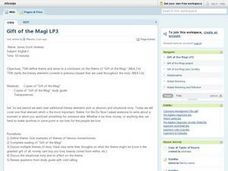
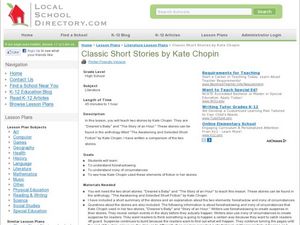


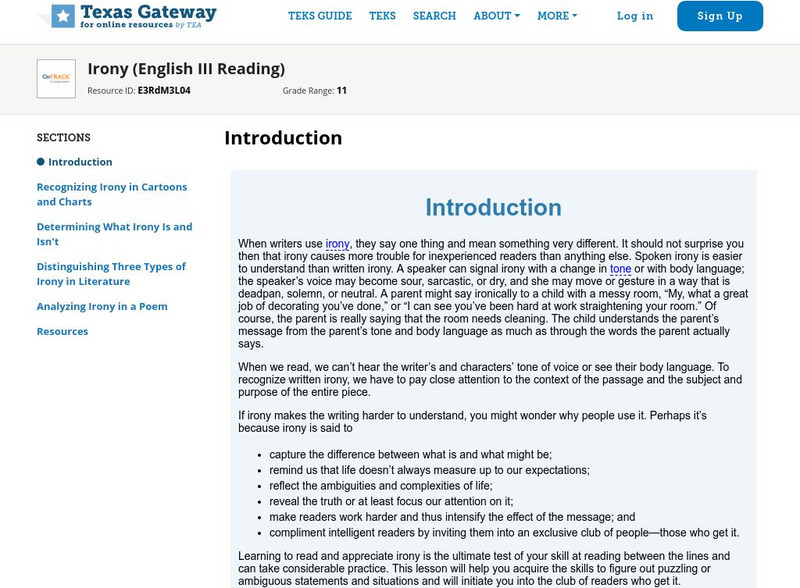
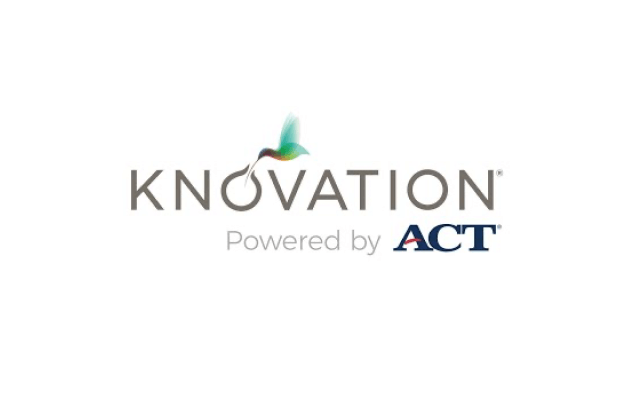
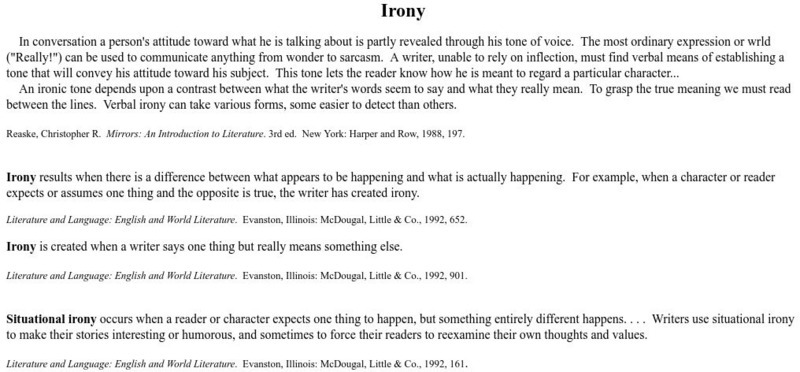
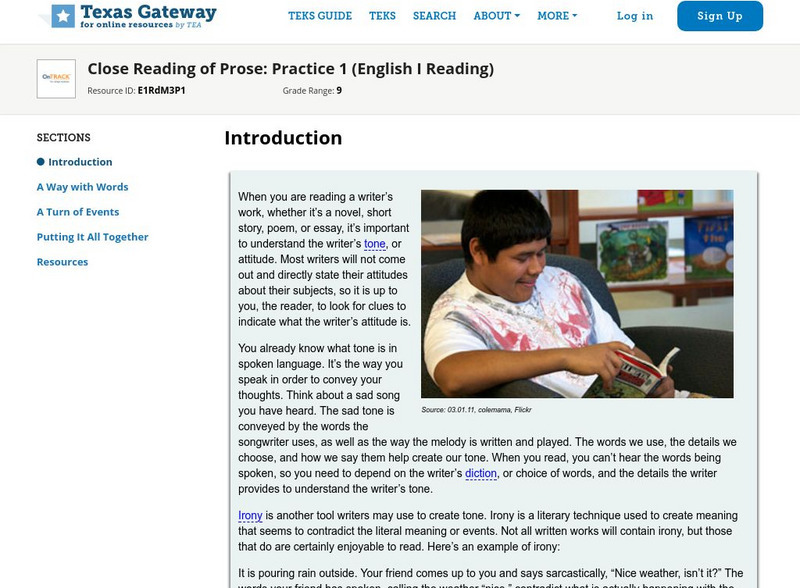


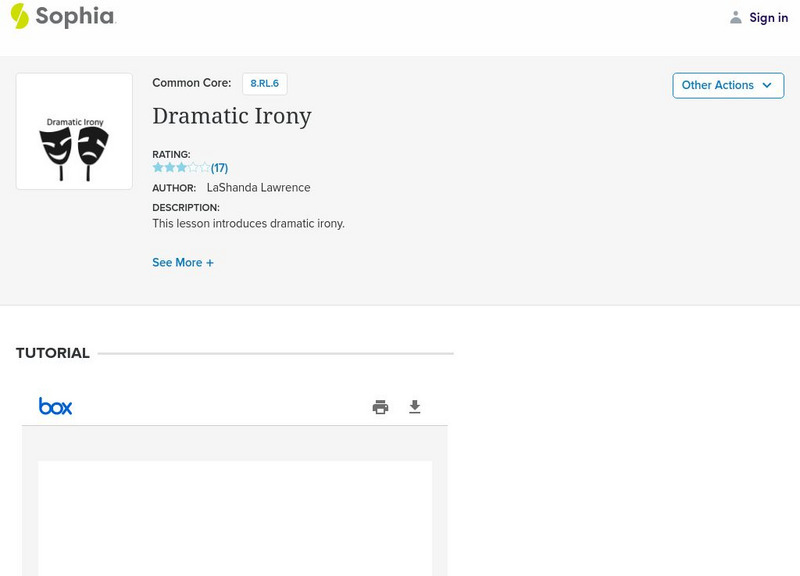
![Holt, Rinehart and Winston: Elements of Literature: Discovering Irony [Pdf] Graphic Holt, Rinehart and Winston: Elements of Literature: Discovering Irony [Pdf] Graphic](http://content.lessonplanet.com/resources/thumbnails/411247/large/bwluav9tywdpy2symdiwmduymc01ndiylxo4dxvqyi5qcgc.jpg?1589993091)